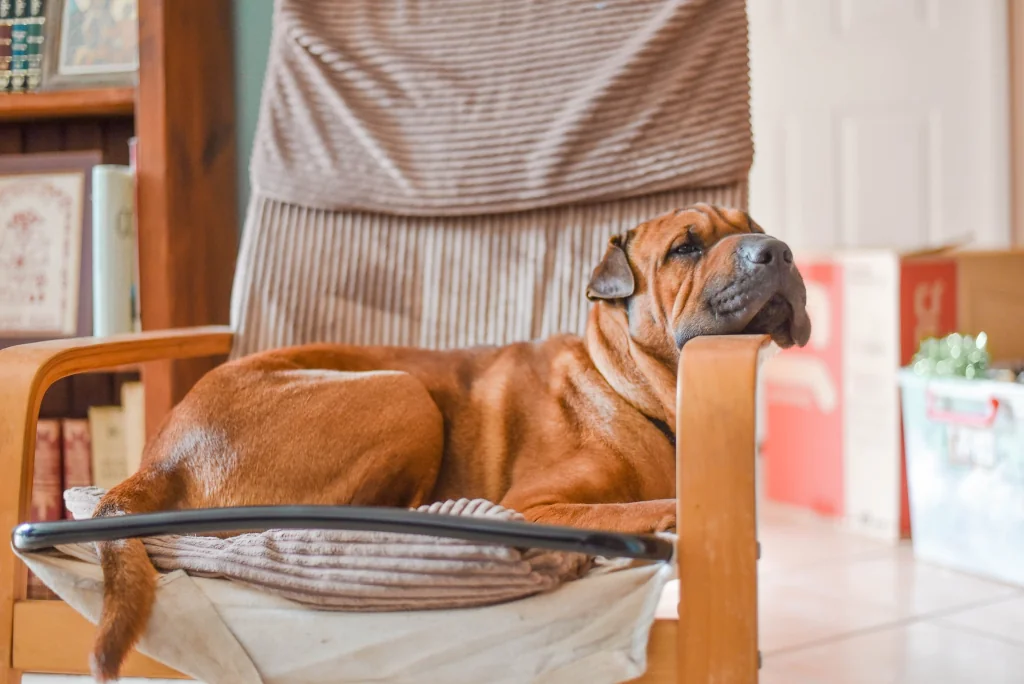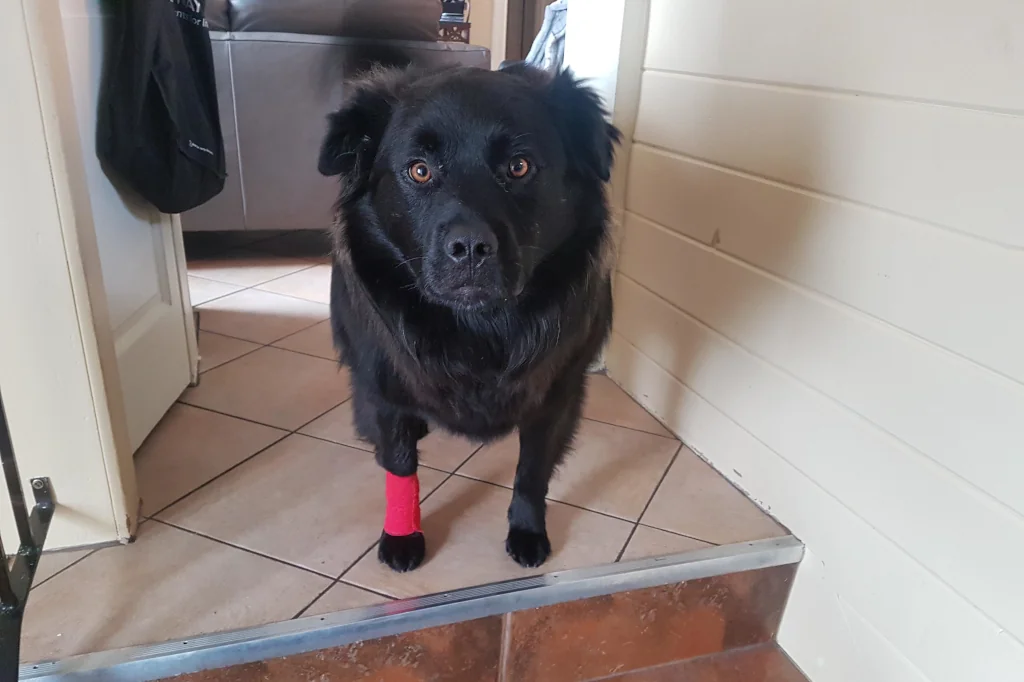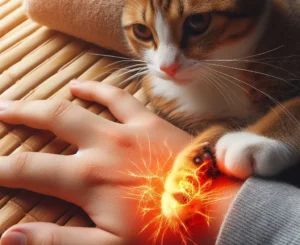Disclosure: We may earn a commission from helpful, relevant links in our content. No cost to you. See our privacy policy.
In the hustle and bustle of everyday life, we often find ourselves thrown in the deep end with unexpected pet emergencies – a cut, a burn, an unexplained limp.
Seeing our loyal canine companions in discomfort is a tough ordeal, almost as if we could feel their pain. But what if you could convert that distress into action?
Armed with a little know-how and some practical guidance, you can do just that. Welcome to your resourceful guide on handling common dog injuries. Stick around, and we might just help you save the day when your furry friend needs you the most.

Common Dog Injuries, and How to Identify Them
With dogs’ exuberant nature and zest for exploring, accidents can happen. Let’s address some common injuries you may encounter and how to identify them:
- Cuts. Look out for bleeding or a sudden onset of limping. Small cuts can often go unnoticed under fur, so if your dog is favoring one paw, check thoroughly.
- Burns. Unusual whining, refusal to eat, or patches of missing hair might hint towards a burn. These can occur from hot surfaces like stove tops or heated car interiors.
- Sprains and Fractures. Dogs are active and sometimes their enthusiasm can lead to injuries. A sudden reluctance to climb stairs or jump could indicate a sprain or fracture.
Remember, these are just common indicators and can vary from dog to dog. Each pet is unique, and knowing your pet’s normal behavior can make it easier to spot when something’s amiss. In such cases, trust your instincts and prioritize your pet’s comfort. You’ve got this, and we’re here to help.
The Precautions: How to Handle an Injured Dog Safely?
The journey of pet parenting requires us to not only shower our dogs with love and affection but also be their protector during times of distress. Hence, learning the right precautions and understanding how to handle an injured dog safely is crucial. Let’s dive in.
Keep Calm and Be Gentle
The first step in dealing with any dog injury is staying calm. This might sound like a tall order, especially when your pet’s in pain, but remember, dogs can pick up on our anxiety. The last thing we want is to agitate them further.
Just the other day, my older dog, Sam, came limping back from the backyard. It was clear something was amiss. Despite the sudden wave of worry, I kept my demeanor calm and spoke to him in a soothing tone. It made all the difference in keeping him cooperative while I inspected his paw.
Secure Your Dog
It’s essential to keep the dog stable, not only to prevent further injuries but also to protect yourself. Even the most placid dogs may snap or bite out of pain.
Use a blanket or a towel to wrap smaller dogs, creating a soothing, swaddling effect. For larger dogs, the blanket can act as a makeshift stretcher for safe transport. Ensure the blanket is firm enough to support your dog’s weight without causing additional discomfort.
Assess the Injury
Before you start any kind of treatment, it’s crucial to understand the nature and extent of the injury. Look for any visible wounds, swelling, or abnormalities. Look for subtle signs like limping or abnormal posture. Examine their body language – are they protective of a certain area?
However, remember, this initial assessment doesn’t substitute a professional evaluation. It merely helps you communicate your dog’s condition more effectively to the vet.
Avoid Direct Handling of Wounds
Unless absolutely necessary, avoid direct contact with the wound. Our hands harbor bacteria that could lead to infection. If possible, wear latex or rubber gloves before starting the first aid process.
If gloves are not available, thoroughly wash your hands with soap before and after handling the injury.
Contact Your Vet
In the case of injuries, your vet should be your first point of contact. Even if the wound seems minor, a professional opinion is invaluable.
When I found a small cut on Sam’s paw, I immediately called my vet, who guided me through the cleaning and bandaging process, helping me avoid potential complications.
Remember, these steps are a guideline to help you navigate through unexpected injuries. Each situation might require a slightly different approach. At the end of the day, what matters is that we’re there for our canine companions when they need us. That’s exactly what I did for Sam and he was back to chasing squirrels in no time.

How to Care for a Dog’s Cut?
With dogs, minor injuries like cuts are not uncommon. If it’s a shallow cut, here are steps to care for it:
- Clean the area. Use warm water and mild soap to gently clean the cut. The goal is to remove any dirt or debris lodged in the wound that could cause infection. Use a soft washcloth or a gentle stream of water from a faucet. However, avoid excessive scrubbing or a strong water pressure that might cause discomfort.
- Apply antiseptic. Pat the area dry with a clean towel, and apply a pet-safe antiseptic. This provides a further line of defense against bacteria. Do not use human-grade antiseptics, like hydrogen peroxide or alcohol, as they can delay healing.
- Bandage the wound. Lastly, protect the cleaned and treated cut with a sterile bandage or gauze. A light, breathable bandage can prevent foreign substances from entering the wound and keep your dog from aggravating it by licking. If your dog seems intent on removing the bandage, a protective collar can help.
Recommended products for managing dog cuts:
- Antiseptic: Vetericyn Wound Care Spray (helps in cleaning the wound area)
- Bandage: 3M Vetrap Bandage Tape (supportive bandage that sticks to itself, not to fur)
- Protective collar: BENCMATE Protective Inflatable Collar (prevents dogs from licking or scratching their wounds)
Keep in mind, a deep cut is unlikely to heal safely on its own. If the cut is deep, continually bleeds, or exposes deeper layers of tissue, seek veterinary help immediately. Cuts like these often require professional cleaning, stitches, or other forms of medical intervention.
Just last summer, my older dog, Sam, got a significant cut from a hidden piece of glass in the grass. We headed straight to the vet, and it was a good thing we did. He needed a few stitches, but thankfully, he recovered beautifully.
How to Care for a Dog’s Burn?
The process for handling burns differs slightly:
- Cool the burn. Apply a stream of cold running water or a cold compress to the burn area for 10-20 minutes. This helps to ease the pain and reduces the heat in the tissues. Avoid ice or freezing water, as it could lead to frostbite and worsen the injury.
- Dry and cover the area. After cooling the burn, gently pat it dry with a clean towel. Avoid rubbing the area as it can aggravate the injury. After drying, loosely wrap the burn with a clean cloth or bandage. This protects the burn from foreign substances and reduces the chance of infection. For burns, a non-stick dressing is often best as it will be less painful during dressing changes.
Recommended products for managing dog burns:
- Burn Treatment Cream: Silver Honey Hot Spot & Wound Care Ointment (great for minor burns)
- Protective Cover: VetMedWear Wound Protective Sleeve for Dogs (for burns located on the limbs, as well as post-surgery recovery protection)
- Pet-safe Pain Relief: LICKS Dog Pain Relief Supplement (OTC pet-safe pain reliever)
- Burn Dressing: Duoderm CGF Sterile Dressings (promotes a moist wound environment )
Just like with cuts, any burn that’s severe, blisters, or is larger than an inch in diameter needs professional medical attention.
Burn injuries in dogs can take anywhere from a few days to several weeks to heal, depending on the severity and treatment provided. Even minor burns should be monitored closely as complications can arise.
Burns can be deceptive. I remember when my younger dog, Charlie, had a small burn from accidentally brushing against a hot grill. It seemed minor initially, but I still decided to consult the vet. It turned out to be a second-degree burn, requiring specialized treatment.
The bottom line: When in doubt, always seek a vet’s advice. Your furry friend will thank you.

When Does a Dog Injury Require a Vet?
Understanding when a dog’s injury is severe enough to necessitate a vet can mean the difference between life and death for your furry companion.
While minor cuts and scrapes can often be managed at home with a well-stocked pet first aid kit, there are certain signs and situations when you should seek immediate veterinary attention. This includes:
- obvious trauma like fractures or heavy bleeding,
- difficulty breathing,
- persistent vomiting or diarrhea,
- seizures, or
- if your dog appears to be in pain or is behaving abnormally.
I learned this lesson first-hand when my younger dog, Charlie, started refusing food one day. Charlie, being an enthusiastic eater, made this change in behavior alarming. He also seemed lethargic and not his usual playful self. Though there were no visible signs of injury, I decided to take him to the vet.
After an examination, we discovered he had swallowed a small toy which was causing a blockage. It’s instances like this where immediate veterinary intervention can save your pet’s life.
We believe in being well-prepared for pet emergencies, and we know you do too. Remember, with your keen intuition, quick thinking, and that unspoken bond you share with your furry friend, you’ve got what it takes to navigate these choppy waters. And through it all, the wagging tail and the loving licks make every challenge worth it.
You’re not just a pet parent. You’re a superhero in your dog’s eyes. So here’s to the love, the challenges, and the triumphs of pet parenting.
FAQs
How to tell if a dog has internal injuries?
Detecting internal injuries in a dog can be tricky as symptoms may not be immediately evident. Some signs include lethargy, loss of appetite, vomiting, changes in breathing, or unexplained behavioral changes. However, any suspicion of internal injuries warrants immediate veterinary attention.
Can I use my first aid kit for my dog?
While some items in a human first aid kit can be used for dogs, like bandages or tweezers, it’s recommended to maintain a separate first aid kit for your dog. This kit should include items like a pet-safe antiseptic, a pet thermometer, and a muzzle for safety during distressing situations.
Should I use a muzzle when treating my dog’s injury?
If your dog is in pain or scared, even the gentlest pet may bite. Using a muzzle during treatment can protect you and anyone helping. However, never use a muzzle if your dog is vomiting, coughing, or having difficulty breathing.
What ointment should I put on my dog’s cut?
A pet-safe antiseptic cream can be applied to a dog’s minor cut after cleaning. Avoid using human ointments unless specified by a vet, as some ingredients might be harmful to dogs if ingested.
Alex, a passionate animal lover, has experience in training and understanding animal behavior. As a proud pet parent to two dogs and three cats, he founded AnimalReport.net to share insights from animal experts and expand his knowledge of the animal kingdom.




